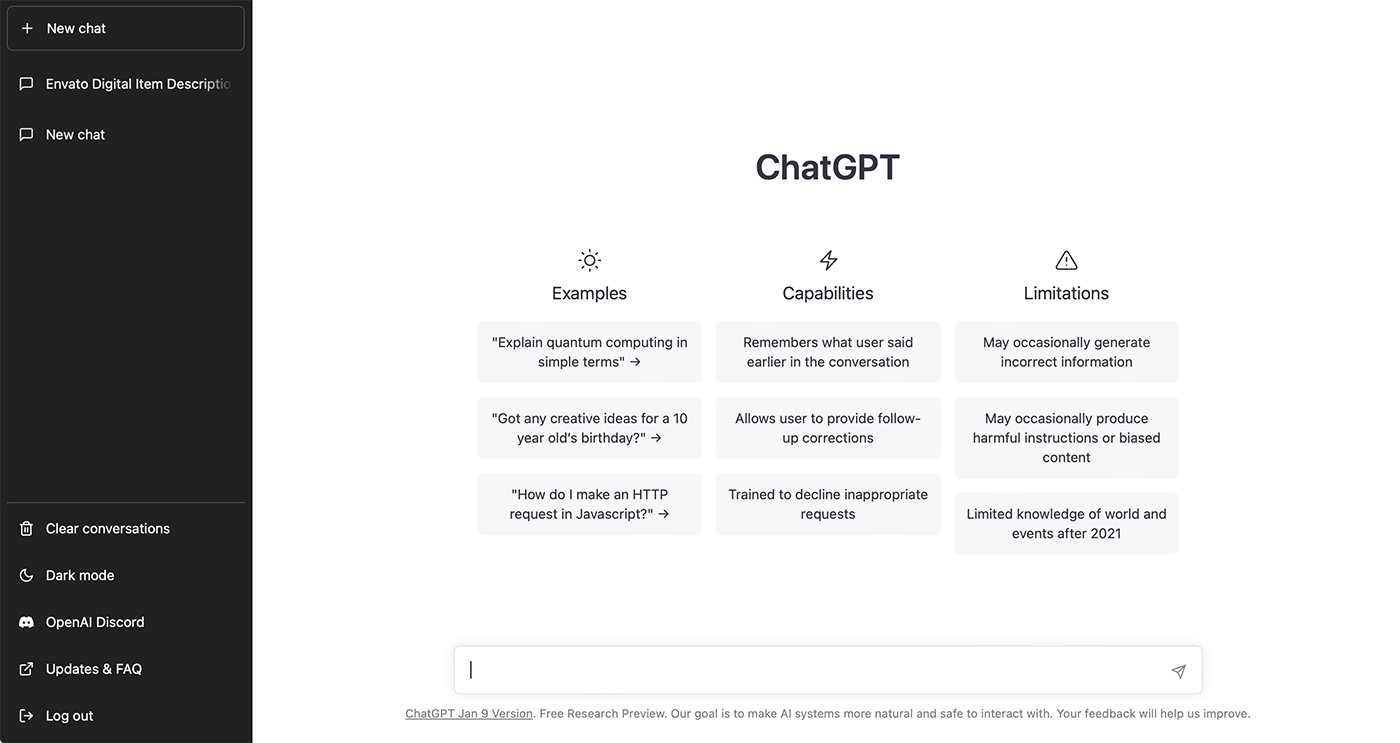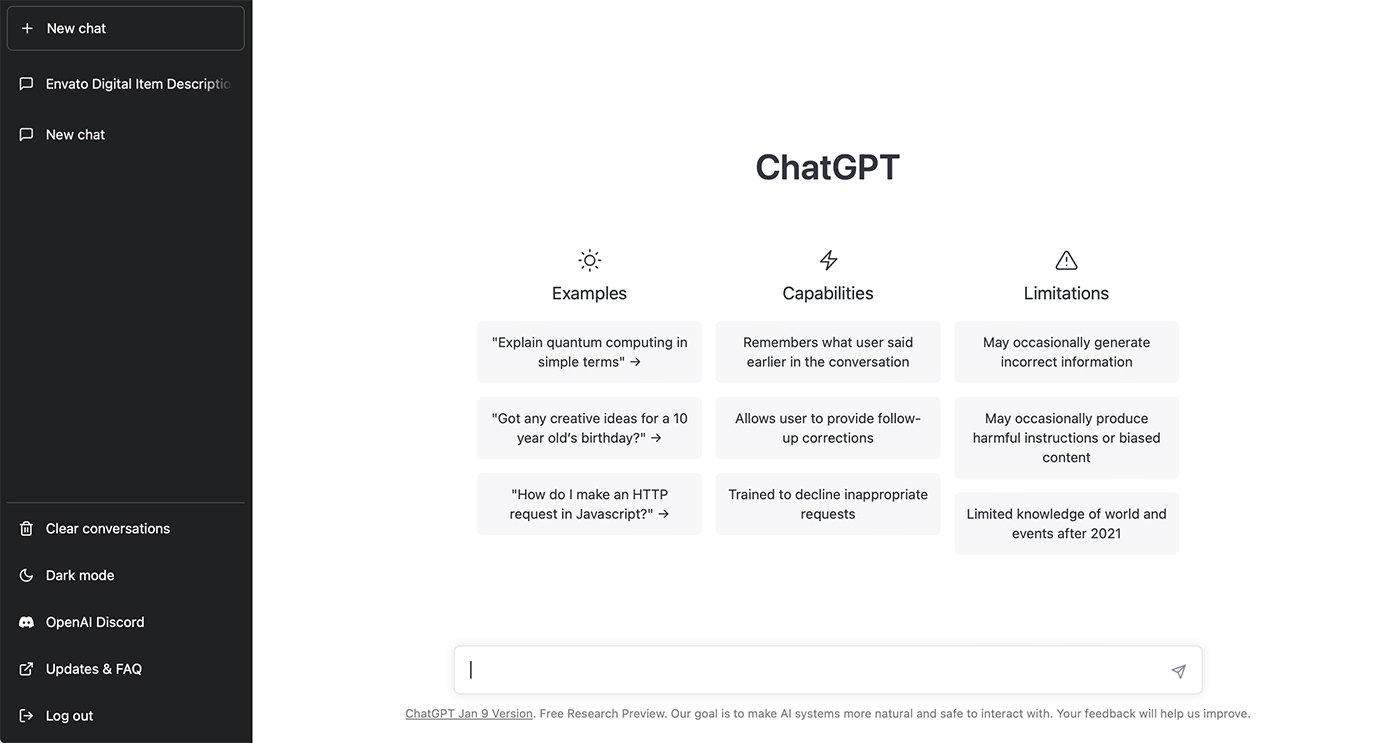
10 Ideas for Using ChatGPT as a Web Designer
- Home Website Design 10 Ideas for Using ChatGPT as a Web Designer

ChatGPT might be one of the most talked-about tools of 2023 so far. It has academics worried about cheating in classrooms, writers worried about their jobs, and everyone concerned about the authenticity of online interactions.
But it does have some value, even for web designers. We’ll take a look at how ChatGPT might be useful for you, ways it might not, and what an AI dialogue and writing tool can actually do for website designers and developers.
Let’s explore what this next stage in the AI revolution can mean for you, as a web designer.

If you haven’t come across it yet, ChatGPT is a natural language processing tool driven by AI technology. It allows you to create and input and have almost human-like conversations with a chatbot. It “knows” how to answer questions and can even do things like compose an email or return lines of code.
The tool is free and open source – at least right now anyway. ChatGPT is in a research and feedback-collection phase.
The tool was created by OpenAI and launched in November 2022. The company is known for creating DALLE•2, a popular AI art generator.
Here’s how OpenAI describes it:
“We’ve trained a model called ChatGPT which interacts in a conversational way. The dialogue format makes it possible for ChatGPT to answer follow-up questions, admit its mistakes, challenge incorrect premises, and reject inappropriate requests. ChatGPT is a sibling model to InstructGPT, which is trained to follow instructions in a prompt and provide a detailed response.
They trained the model using Reinforcement Learning from Human Feedback (RLHF), using the same methods as InstructGPT, but with slight differences in the data collection setup. They trained an initial model using supervised fine-tuning: human AI trainers provided conversations in which they played both sides—the user and an AI assistant. They gave the trainers access to model-written suggestions to help them compose their responses.
While ChatGPT isn’t actually going to help you design anything, it does have some practical application for designers or design teams, much rooted in brainstorming or thinking about project/product development.
Some of the ways this tool could potentially help you include:
Brainstorming ideas on certain topics of keywords to help you visualize projectsGenerating “creative” ideas for design concepts when you are stuck (it will only return text concepts so you still do all the creating)Helping you gather design resources or information on a topic Providing information about an industry or business you may be unfamiliar withHelping you write placeholder text for designsProviding code snippets when you may be stuckGenerating conversation-start prompts to facilitate design discussions with other teamsOffering workflow suggestions when you want to better understand processes
ChatGPT is a new tool and does not replace human experience or interaction. It can be a good place to jumpstart thinking or ideas, but should not be a copy-and-paste addition to your projects.
There’s also no guarantee that information is 100% accurate or phrased correctly and if you are using text from the generator, it’s frankly pretty sterile and cold. We also noticed that some of the results we got back from our inquiries – even those about ChatGPT itself – have some erroneous information. (It told us the tool could help designers resize and compress images and that is not true at this time.)
OpenAI has noted other limitations as well that you should be aware of:
ChatGPT can write plausible-sounding but incorrect answers. It is really sensitive to tweaks in input and phrasing.The AI tends to be quite wordy and overwritten in many cases.When it does not know the answer, the AI “guesses” what your intent may be. It does not know how to ask you a question back.It is supposed to refuse inappropriate requests and references, but sometimes things can sneak through.
We put this thing to the test and actually posed the question to ChatGPT. (Actually, the ask was for 15 suggestions to eliminate ones that just didn’t make sense.)
The result was pretty good and reasonable for the most part, making this a good starter if you need to get the creative juices flowing. It won’t put projects together for you but can help with some planning elements that might facilitate quicker thinking or an overall jumpstart.
Here are 10 of the 15 ideas for using ChatGPT in web design, from the tool itself:
Suggesting font pairings and color palettes based on design preferences. Providing inspiration and ideas for website design and user experience. Automatically generating website copy and content. Creating product descriptions and detailed specifications for e-commerce websites. Generating code snippets for commonly used design elements. Offering design critiques and suggestions for website improvements. Generating design presentations and proposals for clients. Providing insight into website user behavior. Generating prototypes and interactive website mockup ideas. Offering recommendations for design-related tools and resources.
ChatGPT is a new and trendy tool that does have some practical applications for web designers.
It should not be used to write the copy for a website design project, but it can jumpstart your ideas and help you iterate. As a brainstorming and development tool, it does a good job and can help you think of things you might miss on your own.
It has potentially greater use for freelancers as “someone else” to bounce ideas off of when they are feeling stuck.
It will be interesting to see where this tool goes next and how it continues to evolve for web designers and developers.
By: Carrie Cousins
Title: 10 Ideas for Using ChatGPT as a Web Designer
Sourced From: designshack.net/articles/software/chatgpt-for-web-designers/
Published Date: Mon, 30 Jan 2023 10:00:03 +0000
Did you miss our previous article…
https://www.webdesignhawks.com/?p=20805